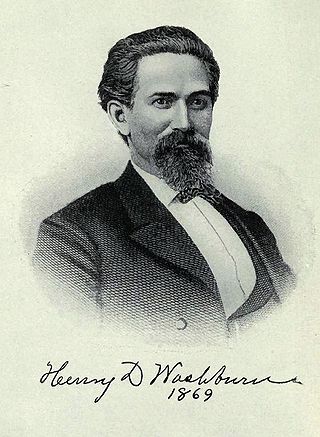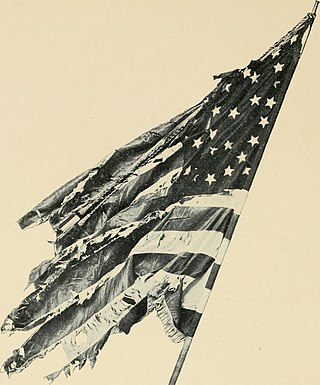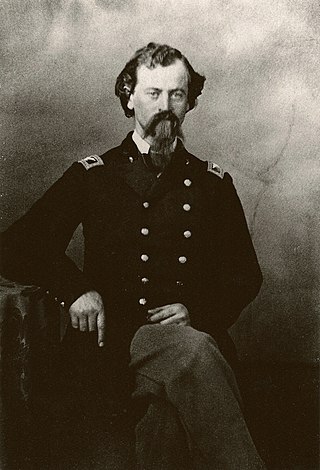Henry Clay Pleasants was a coal mining engineer and an officer in the Union Army during the American Civil War. He is best known for organizing the building of a tunnel filled with explosives under the Confederate lines outside Petersburg, Virginia, which resulted in the Battle of the Crater on July 30, 1864. The Union troops, however, failed in their opportunity to break the Siege of Petersburg.

Henry Dana Washburn was a U.S. Representative from Indiana and a colonel and was breveted twice as brigadier general and major general in the Union Army during the American Civil War.
Kenton Harper was an American newspaper editor, soldier, Indian agent, plantation owner, banker and politician. An officer of the Virginia militia then U.S. Army during the Mexican–American War, Harper later became a Confederate general officer during the American Civil War, and reportedly helped nickname Stonewall Jackson.

The 138th Regiment, Pennsylvania Volunteer Infantry was an infantry regiment that served in the Union Army during the American Civil War.

Charles Henry Tucker "Tucky" Collis was an Irish-American US Army officer who received the Medal of Honor for his actions in the American Civil War.

Louis Wagner was a German-born American military infantry officer who served in the Union Army and as the 9th Commander-in-Chief of the Grand Army of the Republic, 1880-1881.
The 75th Regiment Pennsylvania Volunteer Infantry was a unit of the Union Army during the American Civil War. It was composed almost entirely of German-speaking residents of Philadelphia and newly arrived German immigrants. Total enrollment, over the course of the war, was 1,293 officers and men. The 75th Pennsylvania participated in several major battles including Second Bull Run, Chancellorsville, and Gettysburg. The regiment was transferred to the Western Theater in September, 1863. There, it participated in operations in Tennessee, before it was mustered out of service on September 1, 1865, following the close of the war.
The action at Abraham's Creek was an engagement on September 13, 1864 between Union Army and Confederate States Army forces during a Union reconnaissance in force toward Winchester, Virginia. The action occurred during skirmishing, maneuvering and scouting before the Third Battle of Winchester on September 19, 1864 in the Valley Campaigns of 1864 during the American Civil War. The Union force successfully completed the mission and captured about 173 Confederate prisoners.

The 124th Pennsylvania Volunteer Infantry was an infantry regiment that served in the Union Army during the American Civil War.

The 28th Pennsylvania Volunteer Infantry was an infantry regiment that served in the Union Army during the American Civil War. It was noted for its holding the high ground at the center of the line at Antietam as part of Tyndale's 1st Brigade, Greene's 2nd Division of Mansfield's XII Corps.

William Henry Penrose was a United States Army officer who served in the Union Army during the American Civil War. Penrose commanded the First New Jersey Brigade and ended the war with the rank of brigadier general.
The 119th Pennsylvania Volunteer Infantry was an infantry regiment that served in the Union Army during the American Civil War.
The 27th Pennsylvania Volunteer Infantry was an infantry regiment that served in the Union Army during the American Civil War.

The 215th Regiment Pennsylvania Volunteer Infantry was an infantry regiment of the Union Army in the American Civil War. It was raised in Philadelphia close to the end of the war, and spent most of its slightly more than three months of service guarding Confederate prisoners while garrisoning Fort Delaware.

David Bell McKibbin was a United States Army officer who was made a brevet brigadier general in the final weeks of the American Civil War.

The 213th Regiment Pennsylvania Volunteer Infantry, alternately the 7th Union League Regiment was an infantry regiment of the Union Army in the American Civil War. It was raised in Philadelphia close to the end of the war, and spent its nine months of service on guard duty at Camp Parole and Washington, D.C.

The 196th Regiment Pennsylvania Volunteer Infantry, alternately the 5th Union League Regiment was an infantry regiment of the Union Army in the American Civil War. Raised in Philadelphia in mid-1864, the regiment was made up of Hundred Days Men in an effort to augment existing manpower for an all-out push to end the war within 100 days, and spent most of its service guarding Confederate prisoners of war at Camp Douglas.

The 197th Regiment Pennsylvania Volunteer Infantry, alternately the 3rd Coal Exchange Regiment was an infantry regiment of the Union Army in the American Civil War. Raised in Philadelphia in mid-1864, the regiment was made up of Hundred Days Men in an effort to augment existing manpower for an all-out push to end the war within 100 days, and spent most of its service guarding Confederate prisoners of war at Rock Island.

The 199th Regiment Pennsylvania Volunteer Infantry, alternately known as the Commercial Regiment, was an infantry regiment of the Union Army in the American Civil War. Raised in Philadelphia in late 1864, the regiment enlisted for one year and was sent to the Army of the James during the Siege of Petersburg. During the Third Battle of Petersburg it assaulted Forts Gregg and Alexander, then pursued the retreating Confederate Army of Northern Virginia, fighting at Rice's Station and Appomattox Court House. Following the Confederate surrender at Appomattox, the regiment moved to Richmond, where it mustered out in late June 1865.

The 202nd Regiment Pennsylvania Volunteer Infantry was an infantry regiment of the Union Army in the American Civil War. Raised in the Harrisburg area and the Coal Region in August and September 1864, the regiment was sent to the Manassas Gap Railroad to guard it against the attacks of Confederate partisan rangers led by John Mosby. Following the Union victory at Battle of Cedar Creek, the regiment helped break up the now unneeded railroad and moved to Alexandria to guard the railroad there. After the end of the war, the regiment served in the Coal Region to suppress labor unrest, and was mustered out in mid-1865.










